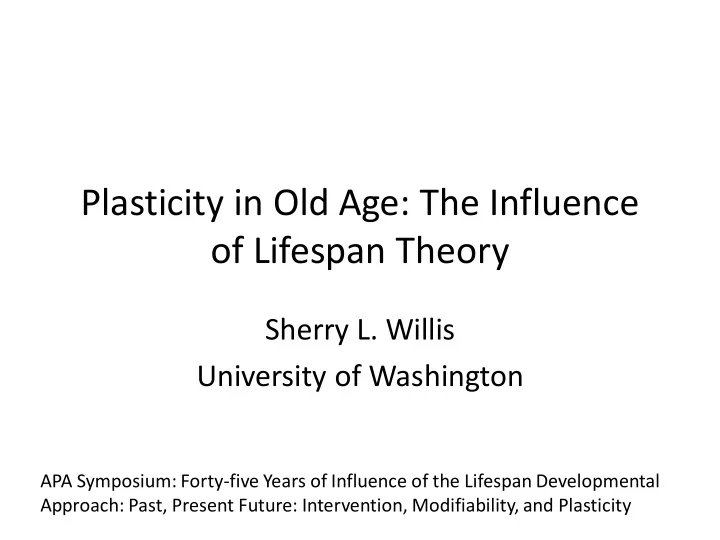

Plasticity in Old Age: The Influence of Lifespan Theory Sherry L. Willis University of Washington APA Symposium: Forty-five Years of Influence of the Lifespan Developmental Approach: Past, Present Future: Intervention, Modifiability, and Plasticity
Ray Cattell & John Nesselroade First Presentation of ADEPT: Paul Baltes, Rosemary Blieszner, Steve Cornelius, Margie Carolyn Nesselroade – ADEPT Coordinator Lachman, Brian Hofland
Training at Shell Point Mike Marsiske,Carolyn Nesselroade Manfred Diehl, Mike Marsiske, Carolyn
ADEPT & SLS Groups ACTIVE Group
Plasticity in Cognitive Aging: Two Theoretical Perspective I. Magnification Perspective – Training would magnify individual differences (e.g. age) in cognition – More able would exhibit greater plasticity • Outcome: Level of performance – Design: Cross-sectional. Compare young & old • Life-span – Intervention: Practice on task with no strategies or instruction – Target: • Cognitive abilities • Neural plasticity precedes behavioral/cognitive change Lindenberger, Lovden, Jaeggi, Lustig, Kuhn, Baltes, Li,
Plasticity in Cognitive Aging: Two Theoretical Perspective I. Compensatory Perspective – Focus on elderly, not young-old comparison – Focus range of plasticity in elderly – Individual differences reduced, not magnified as functioning of training – low functioning gain more – Design: Treatment – control group comparison – Intervention: instruction & strategies, rather than practice – Target: • Cognitive abilities • Neural plasticity – low functioning may increase activation while higher functioning may decrease activation – outcomes vary with baseline level Rebok, Marsiske, Willis, Belleville, Schaie, Gross, Parisi, Bier, Labouvie- Vief,Boron, Saczynski
Types of Behavioral Interventions I. Strategy training – Compensatory Approach – Episodic memory (Rebok, ) – Reasoning/Executive training (Willis, ) – Transfer – transfer to tasks of same ability; limited transfer to other abilities II. Whole Task Practice – Magnification Approach – N-back (working memory) • (Jaeggi, 2008; Au et al, 2015) – Transfer – considerable debate regarding transfer
Types of Behavioral Interventions III. Component-specific & Variable Priority – Reduce complexity of task by successively focusing on different components of task (Kramer, Boot,Bherer,) – Adaptive training – individualized training • Calibrate change in item difficulty and speed – Speed of Processing (UFOV) – variable priority • Ball, Edwards, Ross,Wadley Transfer – Transfer within multiple components. No transfer to memory or reasoning in ACTIVE trial – Increase attention in dual task – MCI • Gagnon & Belleville, 2012
Types of Behavioral Interventions IV. Multiple Domain Training – Combine Strategy & Component-Variable Priority – MEMO (Belleville) – Utilization of multiple strategies • Loci, face-name, imagery • Pretraining on attention • Practice in Real life situations V. Computer & Mobile Training: Two Approaches 1. Research-based cognitive training 2. Commercial product – casual video gaming Boot, Charness, Kueider, Lampit,Baniqued,Basak,Voss, Kramer
Types of Behavioral Interventions V. Computer & Mobile Training: Two Approaches 1. Research-based cognitive training – Enhance training via technical resources – Adaptive training, graphics 2. Commercial - Casual video gaming – Unclear specific abilities being trained by games – Findings not reported in High impact journals – Consensus reports – Express concerns – Lower satisfaction amg elderly users
Neuroimaging: Predictor of Training & Outcome of Training I. Baseline Neuroimaging as Predictor: – Baseline Hippocampal volume predict Episodic memory training effects – Striatum volume predict Attention Control II. Neuroimaging as Training Outcome: – Training can increase or decrease neural activation on task, depending on baseline level of activation Belleville, Lustig, Park, Dahlin, Nyberg, Engvig,Kramer, Brehemer
Success of Cognitive Training • Cognitive plasticity has been shown for a number of different abilities, involving a variety of intervention approaches • Training effects have been shown for: – Cognitively Normal – MCI – Demented • Training effects in normal elderly are durable – ACTIVE trial reported maintenance of training (compared to control) at 10-year follow-up
Issues in Behavioral Interventions Training Success BUT: Various Approaches Focused on Different Cognitive Domains: – Strategy training – episodic memory, reasoning – Whole task practice – n-back, working memory – Component-variable priority – attention, speed of processing, Comparisons are Difficult! Limited comparison of training same ability with different approaches!
Current & Future Directions • Neural – Brain Stimulation • Training & Real World Tasks • Cognitive Engagement and Leisure Activities – Quilting, Photography (Park) – Senior Odyssey (Stine-Morrow) • Cognitive Engagement & Volunteer Activities – Experience Corp (Carlson, Rebok) • Job Training & Everyday Tasks with Seniors – CREATE
How to Embed Cognitive Engagement in Elderly’s Daily Life?
Nutrition & Exercise Pyramids?
Embedding Engagement in Daily Life • What are the basic components of cognitive engagement? – Primary abilities? – Executive Functions? – Frequency? – Intensity? – Physical & Social Context – Individual Differences? – Personalized or Individualized? – What is Successful Aging?
Recommend
More recommend